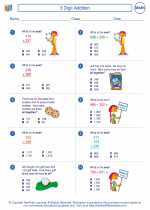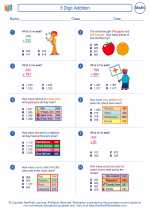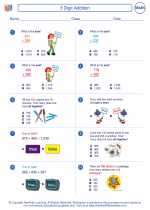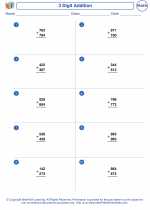Operations in Math
In math, operations refer to the basic mathematical processes of addition, subtraction, multiplication, and division. These operations are used to solve mathematical problems and perform calculations.Addition
Addition is the process of combining two or more numbers to find their total sum. It is denoted by the plus symbol (+). For example, 3 + 4 = 7, where 3 and 4 are added to get the sum 7.
Subtraction
Subtraction is the process of taking one number away from another to find the difference. It is denoted by the minus symbol (-). For example, 9 - 5 = 4, where 5 is subtracted from 9 to get the difference 4.
Multiplication
Multiplication is the process of repeated addition or combining equal groups. It is denoted by the multiplication symbol (×). For example, 3 × 2 = 6, where 3 is multiplied by 2 to get the product 6.
Division
Division is the process of splitting a number into equal parts or finding out how many times one number is contained in another. It is denoted by the division symbol (÷). For example, 12 ÷ 3 = 4, where 12 is divided by 3 to get the quotient 4.
Study Guide for Operations
Addition and Subtraction
To practice addition and subtraction, students can use flashcards, play math games, or solve word problems. It is important for students to understand the concept of combining or taking away numbers, as well as the relationship between addition and subtraction (e.g., 8 - 3 = 5, and 5 + 3 = 8).
Multiplication and Division
For multiplication and division practice, students can use multiplication tables, arrays, or solve real-life problems involving equal groups. It is essential for students to grasp the concept of repeated addition for multiplication and splitting into equal groups for division. Understanding the relationship between multiplication and division is also crucial (e.g., 4 × 3 = 12, and 12 ÷ 3 = 4).
Problem-Solving
Students should practice solving word problems that involve all four operations. These problems help students apply their understanding of addition, subtraction, multiplication, and division in various contexts, developing their problem-solving skills.
.◂Math Worksheets and Study Guides Third Grade. 3 Digit Addition

 Worksheet/Answer key
Worksheet/Answer key
 Worksheet/Answer key
Worksheet/Answer key
 Worksheet/Answer key
Worksheet/Answer key
 Worksheet/Answer key
Worksheet/Answer key
